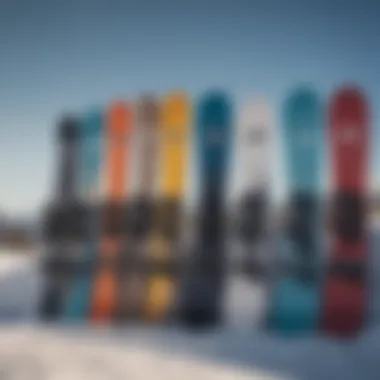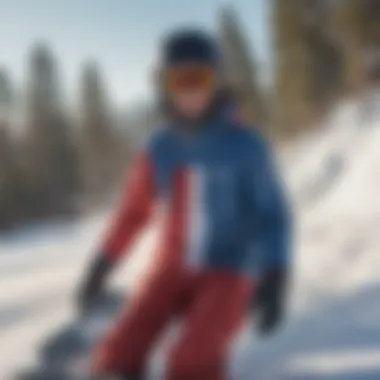Snowboarding Rentals in Big Bear: Prices & Options


Intro
Snowboarding is more than just a sport; it is an exhilarating experience that combines skill, balance, and the beauty of winter landscapes. Big Bear, situated in the San Bernardino Mountains of Southern California, offers a premier destination for snowboarding enthusiasts. This article delves into the intricacies of snowboarding rentals in Big Bear, examining pricing, gear options, and essential insights for both beginners and experienced boarders.
Extreme Sport Overview
Snowboarding emerged in the late 1960s and early 1970s, evolving from a blend of surfing and skiing. Its popularity surged in the 1990s, leading to its inclusion in the Winter Olympics in 1998. As a winter sport, snowboarding demands specific equipment, techniques, and adherence to safety standards.
The equipment required for snowboarding includes a snowboard, boots, and bindings. Choosing the right gear can affect performance and safety significantly. Beginners will find soft-flex boards easier to handle, while seasoned snowboarders often opt for stiffer boards that provide better control at higher speeds.
Safety is paramount in snowboarding. Riders must wear helmets to protect against head injuries, and padded clothing can add another layer of protection. The importance of understanding the terrain is also critical; knowing how to navigate slopes safely can prevent accidents.
Did you know? Approximately 7.8 million people participate in snowboarding in the United States each year, with rentals being a primary option for many.
Relevant Statistics and Facts
- The average snowboard rental cost in Big Bear ranges from $35 to $60 per day.
- Snowboarding injuries account for about 20% of winter sports accidents, with wrist fractures being the most common.
- Big Bear averages over 100 days of snowboardable snow each winter season.
Prologue to Snowboarding in Big Bear
Snowboarding in Big Bear is not just an activity; it symbolizes the thrill of winter sports in an ideal setting. The region attracts enthusiasts from various backgrounds, ranging from casual vacationers to extreme athletes. This section provides valuable insights into the significance of snowboarding in Big Bear, alongside an overview of the locale's unique features. Understanding these elements is essential for anyone considering renting equipment or engaging in snowboarding here.
Overview of Big Bear Lake
Big Bear Lake is a mountain resort community located in Southern California. The area features stunning alpine scenery and provides ample opportunity for outdoor sports. It is known for its picturesque lake, charming village, and access to several ski resorts like Bear Mountain and Snow Summit. The elevation and Mediterranean climate mix snow with sunny days, providing an ideal environment for snowboarding enthusiasts during the winter months.
The lake itself is surrounded by pine trees and mountain ranges, creating a serene atmosphere. Winter transforms Big Bear into a snow-covered wonderland, making it a popular destination for winter sports lovers. Visitors often engage in activities beyond snowboarding, such as skiing, tubing, and snowshoeing, thus enhancing the entire winter experience. This diversity of options attracts a wide range of visitors and increases the demand for snowboarding rentals.
Significance of Snowboarding in the Region
Snowboarding holds a prominent place in Big Bear's winter culture. The sport not only serves as an outlet for adrenaline seekers but also contributes to the local economy through tourism. Many rental shops, snowboarding schools, and associated businesses thrive because of the visitor influx. The region is particularly popular with younger crowds and families, further emphasizing the broad appeal of snowboarding.
Moreover, local events and competitions often highlight snowboarding talent. These gatherings not only showcase athletes but also foster community spirit. Big Bear's commitment to creating a welcoming environment for beginners and skilled riders alike enhances its reputation as a snow sports destination. Being aware of this significance can help those planning to rent gear better appreciate the community they are entering and the culture surrounding their experience.
Rental Market Insights
The rental market for snowboarding equipment in Big Bear plays a crucial role in the overall experience of winter sports enthusiasts. This segment not only supports the advent of new riders but also caters to seasoned athletes looking for gear upgrades or conveniences. The insights drawn from the rental market can help consumers make informed decisions, optimizing both their experience on the slopes and their budget.
Current Trends in Rentals
Over the past few seasons, the trend in renting snowboarding gear has seen significant developments. More riders now seek flexibility and convenience, which has encouraged rental shops to adapt their offerings. Many places have introduced online booking systems, allowing for time-saving reservations. This method is becoming the norm, especially for those planning trips on weekends or holidays.
In addition to technology shifts, environmental considerations are also impacting the rental market. Many shops now offer eco-friendly and sustainable equipment options, appealing to environmentally conscious consumers. There is a growing preference for renting rather than buying, especially among younger athletes who might not want to commit to equipment investments until they have truly developed their skills.
Comparison of Local Rental Shops
Each rental shop in Big Bear has its own unique offerings, pricing, and customer experience. It is essential for renters to compare these elements before making a choice. Some notable rental shops include:
- Goldsmith’s Board and Ski: Known for its wide selection of high-quality gear and exceptional customer service. Prices are competitive, especially with their weekly rental options.
- Big Bear Mountain Resort Rentals: Offers a seamless experience with an extensive inventory. However, their prices can be a bit on the higher side during peak season.
- Snow Summit Rentals: Provides great package deals for families or groups, making it an excellent choice for those traveling together.
When choosing a rental shop, factors like equipment availability, location, and customer reviews should not be overlooked. A well-informed choice will ensure that both novices and experienced riders find suitable gear tailored to their needs.
Types of Snowboarding Equipment Available for Rent
Understanding the types of snowboarding equipment available for rent is essential for any enthusiast visiting Big Bear. This knowledge not only assists in making informed decisions but also enhances the overall snowboarding experience. Different riders have unique preferences, and knowing the variety of equipment can cater to these preferences. Whether one is a novice or an experienced rider, having the right gear is crucial for performance and safety on the slopes.
Snowboards: A Detailed Breakdown
Snowboards are the foundation of any snowboarding experience. There are several types of snowboards available for rent, each designed for specific styles and conditions. Freestyle boards are typically shorter and more flexible, catering to those who enjoy tricks in terrain parks. All-mountain boards offer versatility, ideal for riders who navigate various terrains. For those seeking speed on groomed runs, carving boards are essential.


Considerations when selecting a snowboard include length, width, and flex. Renters should know their height and weight, as this impacts board size. All snowboards come with adequate instruction regarding their use. Additionally, rental shops often provide a quick overview of how boards perform in different snow conditions.
Bindings and Boots Explained
Bindings and boots are as significant as the snowboard itself. Bindings connect the rider’s boots to the snowboard, and their correct adjustment is vital for safety and performance. There are two primary types of bindings: strap-in and rear-entry. Strap-in bindings are the most common. They provide great stability. Rear-entry bindings are easier to get in and out of, making them ideal for beginners.
Boots are the interface between the rider and the equipment. They should fit well. A snug fit helps enhance control and responsiveness. Rental shops usually offer various sizes and flex ratings. It can be helpful to try several pairs before settling on one. Comfort plays a major role, especially during extended sessions on the slopes.
Additional Gear: Helmets and Protective Wear
Safety cannot be overstated when participating in snowboarding. Helmets should be a non-negotiable component of any rental package. Many shops offer high-quality helmets that conform to safety standards while providing comfort and ventilation.
In addition to helmets, protective wear such as wrist guards and padded shorts can significantly minimize injury risk. With falls being a common occurrence, wearing appropriate gear can help novices and seasoned riders enjoy their rides with greater peace of mind.
"Investing in quality protective gear not only enhances safety but also boosts confidence while navigating the slopes."
Additionally, some shops offer customizable gear packages, allowing renters to choose what they feel is necessary for their ride. Knowing what options are available contributes to an enhanced experience.
Understanding Rental Pricing
Understanding the pricing structure for snowboarding rentals is crucial for both novices and experienced riders. It helps to create a budget and make more informed decisions regarding gear selection. Each rental shop might have different pricing models, which can lead to confusion. By examining the distinctions between daily and weekly rental rates, identifying factors that influence costs, and conducting a comparative analysis of rental prices, one can navigate the rental market more effectively. This section aims to shed light on these elements, ensuring that readers can approach their rental experience with confidence and knowledge.
Daily vs. Weekly Rental Rates
When evaluating rental pricing, it’s essential to consider the difference between daily and weekly rates. Daily rentals are straightforward. Riders pay for each day they rent the equipment. This can be suitable for those who are not planning extended stays or only wish to snowboard briefly. However, costs can accumulate quickly if a renter seeks multiple days on the slopes.
In contrast, weekly rentals often present more value. Many shops offer discounts for extended rentals. Rates can decrease significantly per day when equipment is rented for a full week. For instance, the daily rate might be $50, while a weekly rate could be around $250, translating to roughly $35 a day. This is an attractive option for dedicated athletes wanting to maximize their time on the mountain without incurring high costs.
Factors Influencing Pricing
Several elements come into play when determining rental prices.
- Seasonality: Prices can change based on peak and off-peak seasons. High demand during holidays can drive costs higher.
- Equipment Type: Premium gear often comes at a higher cost. Specialized snowboards or the latest models attract a premium over entry-level options.
- Rental Duration: As discussed, the length of the rental impacts the overall price.
- Location of Rental Shop: Shops closer to ski resorts may impose higher prices compared to those located further away.
- Insurance Options: Some shops offer insurance for equipment damage or theft, impacting the final rental price.
These factors emphasize the need for potential renters to carefully evaluate their choices based on personal needs and available budget.
Comparative Analysis of Rental Costs
A comprehensive evaluation of rental costs in Big Bear reveals significant variations among local shops. Some may specialize in premium gear, while others cater to budget-conscious renters. One can gain clarity by comparing not only prices but also the gear quality offered.
- Gear Quality: Not all rentals are created equal; some shops maintain their gear better than others.
- Availability of Packages: Some stores provide bundled packages which can save money, especially for groups or families.
- Customer Reviews: Insights from previous customers regarding pricing fairness and service can greatly influence where to rent.
Making a side-by-side comparison aids in making a choice that aligns with your needs. Evaluate each shop's offers to find great deals without compromising on quality.
"Understanding the nuances of rental costs can lead to significant savings for the savvy snowboarder."
By grasping these considerations, snowboarding enthusiasts can secure suitable and affordable gear for their adventures at Big Bear.
Deals and Discounts on Rentals
Deals and discounts on snowboarding rentals are a crucial element for many enthusiasts visiting Big Bear. They provide opportunities for cost savings, making it more affordable for both casual and frequent snowboarders to enjoy the slopes without the burden of excessive expenses. Understanding the available deals allows renters to make informed decisions, maximizing their experience while minimizing costs. This section will outline the key types of discounts and special offers that can significantly influence rental decisions.
Seasonal Promotions
Seasonal promotions are typically offered during peak and off-peak periods. These promotions can vary widely, often including discounts on daily rental rates, special package deals, or even free add-ons like helmets or other gear. For example, during the holidays or major snow events, many rental shops provide discounts that can lead to considerable savings for families or groups looking to hit the slopes.
For instance, some shops may offer rates such as 20% off during the holiday week or special pricing for weekday rentals. Awareness of these seasonal promotions enables renters to leverage these savings, encouraging longer stays or additional equipment rentals.
Group Deals and Packages
Group deals and packages stand out as another beneficial option for those skiing or snowboarding with friends or family. Many rental companies in Big Bear recognize the collective purchasing power of groups. Hence, they often provide flat-rate pricing or discounts based on the number of individuals renting equipment together.


A common offer might include a 15% discount for groups of six or more, which can reduce overall costs substantially. Additionally, some shops may bundle ski passes with equipment rentals for a reduced total price. For example, a package offer could include gear rental and day lift tickets at a significantly lower rate than booking separately, enhancing the experience while promoting social enjoyment on the slopes.
Loyalty Programs and Membership Benefits
Loyalty programs are intended to reward repeat customers and can represent significant value for frequent visitors to Big Bear. These programs may offer various benefits, including exclusive discounts, priority rentals, and extended rental hours. For instance, signing up for a loyalty program might yield a 10% discount on every rental or even a free day of rental after a certain number of visits.
Membership benefits can extend beyond just discounts. Some rental agencies might provide complimentary services, like gear tuning or maintenance, for members. Memberships may also grant early access to seasonal sales or exclusive promotions unavailable to regular customers. In this way, loyalty programs not only foster customer retention but also promote a sense of community among renters.
"As competition among rental shops grows, customers can leverage these deals to enhance their snowboarding experience without overspending."
Rental Process Overview
Renting snowboarding equipment is a critical aspect for any winter sports enthusiast visiting Big Bear. The rental process is designed to be efficient and user-friendly, ensuring that both novices and seasoned riders can quickly access the gear they need. Understanding this process can significantly enhance one’s experience on the slopes. In this section, we will dive into the key elements of the rental process, including the reservation procedures, the choice between physical store visits and online rentals, and what to expect during gear pickup.
Reservation Procedures
Making a reservation for snowboarding equipment is essential for ensuring availability, especially during peak seasons. Most rental shops in Big Bear offer various methods for securing equipment ahead of time. The online reservation system has become increasingly popular, allowing renters to select their desired gear, specify the rental duration, and often enjoy discounts.
To make a reservation:
- Visit the official websites of local rental shops.
- Browse available equipment and check for quality specifics.
- Complete the online form with your personal details.
- Confirm your payment method.
Local shops like Big Bear Mountain Resort and Snow Valley also accept phone reservations, providing an alternative for those who prefer direct contact. This is particularly useful for individuals with specific gear requests. When reserving equipment, it is recommended to check the cancellation policy, as changes in weather can affect travel plans.
Physical Store Visits vs. Online Rentals
Deciding whether to rent snowboard gear online or in-store involves weighing convenience against personal service. Online rentals allow for a fast and straightforward process, giving you the ability to compare prices and gear options from the comfort of your home. However, relying on this option may lead to sizing and fitting issues, which could affect performance.
Visiting a physical store allows you to try on gear and make real-time adjustments with the assistance of experienced staff. This face-to-face interaction often results in better fitting and personalized recommendations based on individual riding styles. Store visits can also provide the benefit of purchasing last-minute items if you forget to pack essentials.
What to Expect Upon Pickup
When picking up your rented equipment, expect a systematic and efficient process. Upon arrival, you’ll present your reservation confirmation, along with identification. The staff will guide you through the following steps:
- Confirm your rental details, ensuring everything aligns with your reservation.
- Stay alert for the gear inspection, where you and the staff will check for any pre-existing damage.
- You will complete any necessary paperwork, including liability waivers, before officially taking possession of the equipment.
Understanding the rental process can mean the difference between a frustrating experience and a seamless day on the slopes. With a solid grasp of reservation procedures, the pros and cons of online versus in-store rentals, and expectations upon pickup, you will be well-prepared for an enjoyable snowboarding adventure in Big Bear.
Rental Equipment Maintenance and Care
Maintaining and caring for rental snowboarding equipment is crucial for both the performance of the gear and the safety of the users. Proper maintenance leads to optimal performance, which is essential for a safe and enjoyable snowboarding experience. This section will cover pre-rental inspections and post-rental return procedures to ensure customers understand the significant aspects of this topic.
Pre-Rental Inspections
Before a snowboard can be rented out, it should undergo a comprehensive inspection. This process checks for several key elements:
- Board Condition: Inspect the snowboard for any visible damage such as deep scratches or gouges. Uneven edges or worn-out bases can greatly affect performance.
- Bindings Functionality: Ensure bindings are fully operational. They should firmly secure the rider's boots without any excess movement. The straps must not be frayed or worn out.
- Boot Comfort: Check the inner lining of the boots and the soles for any signs of wear. Rented boots should provide adequate support and comfort to avoid blisters or injuries during use.
- Safety Gear: Helmets and protective wear should also be inspected for any signs of damage. Any safety equipment that shows wear or should be replaced before rentals.
By performing these inspections, rental shops can help avoid issues on the slopes that might arise from faulty equipment. Riders, especially enthusiasts seeking high performance, must be aware of this process as it directly impacts their experience.
Post-Rental Return Procedures
Once a customer has finished using rented gear, returning it promptly and in good condition is important. The following steps outline what typically occurs:
- Return Inspection: Rental staff should conduct a brief inspection to look for damage or excessive wear. This includes checking the snowboard, bindings, and boots for any issues that developed during use.
- Clean Up: Customers are often encouraged to clean any snow or debris off the gear before return. This simple act helps in the maintenance of the equipment.
- Damage Reporting: If any damage is found, the rental shop needs to inform the customer. Discussing damages immediately can prevent misunderstandings or disputes later.
- Feedback Opportunity: After returning equipment, customers should be invited to share their feedback on the gear. This input can be invaluable for rental shops to enhance their equipment choices and rental processes moving forward.
By ensuring a thorough post-rental process, rental agencies can maintain a high standard of gear and service, ultimately benefiting future customers and promoting safety on the slopes.
"Maintenance and customer feedback are key to keeping rental equipment in top condition."
Considerations for Novices and Experienced Riders


When it comes to snowboarding in Big Bear, both novices and experienced riders face unique challenges and opportunities that can significantly influence their rental experience. Understanding these distinctions is crucial for making informed decisions that enhance the overall adventure on the slopes.
Gear Selection for Beginners
For beginners, selecting the right gear is not just about the latest trends; it is about comfort and suitability. Novice riders often benefit from softer flex snowboards, which are generally more forgiving during turns and help in learning the basic techniques. Bindings should also be user-friendly, allowing easy entry and exit. Boots, perhaps the most critical part of the setup, need to provide sufficient support while being comfortable.
Consider renting from shops that offer complete packages tailored for beginners. These packages often include a well-matched snowboard, boots, and bindings, all designed to work together efficiently. Furthermore, many rental shops in Big Bear provide expert advice, helping newcomers choose gear suited to their skill level.
Advanced Equipment for Seasoned Riders
For seasoned riders, gear selection revolves around performance in diverse conditions. More experienced snowboarders often prefer a stiffer board for better responsiveness at higher speeds and superior control on complex terrain. High-performance bindings can enhance the riding experience by providing more precise flexion and response.
Riders should also pay attention to specific features that can significantly affect their performance. For example, choosing a board with a camber profile suited to their style—whether park, all-mountain, or powder—can make a substantial difference. Rental shops frequently have boards designed for specialized riding styles. Therefore, it is wise for seasoned riders to ask for options that align with their specific needs.
"Investing in quality gear enhances not just the performance but also the enjoyment of your time on the slopes."
In summary, understanding the differences in gear needs between novices and experienced riders enhances the rental process. Beginners should focus on comfort and ease of use, while seasoned riders must consider performance and specialization of equipment. Both groups can benefit from the expertise provided by local rental shops, which can lead to a more enjoyable snowboarding experience in Big Bear.
Customer Service and Support
Customer service plays a critical role in the snowboarding rental experience at Big Bear. The level of support provided by rental shops directly influences customer satisfaction. This is especially essential for enthusiasts, whether they are beginners trying snowboarding for the first time or seasoned athletes searching for high-performance gear. A positive experience not only encourages repeat business but also fosters a recommendation culture, crucial in a tight-knit community of sport lovers.
First, a good customer experience can enhance the overall enjoyment of the snowboarding adventure. Rental shops that prioritize customer service ensure that renters feel comfortable and confident in their gear choices. This becomes especially significant during peak seasons, when shops might be overwhelmed with customers.
Second, effective communication can prevent misunderstandings regarding equipment specifications, pricing, and policies. Knowledgeable staff can provide valuable insights and recommendations, improving the selection process for riders. This is particularly beneficial for newcomers who may lack experience and require additional guidance.
Third, attentive customer support also builds trust. Customers are more likely to invest in equipment when they feel assured of proper assistance in case of issues. This trust leads to loyalty, which is especially important in a competitive market.
Importance of Customer Experience
The significance of customer experience cannot be overstated. It serves as the foundation for any successful rental business. Happy customers are not only more likely to return but also share their experiences with others.
Providing a seamless rental process is key. From the moment a customer walks through the door, they should be greeted warmly and treated with respect. Staff training is essential. Employees should be well-informed about the equipment and policies, empowering them to assist customers effectively.
In addition, an efficient checkout process enhances the customer experience. Long wait times can lead to frustration, potentially souring the interaction before it has even begun. Rental shops utilizing technology, such as digital checklists and mobile apps, can streamline operations, facilitating a quicker experience for customers.
Lastly, gathering feedback from customers plays an essential role in understanding and improving service. Engagement through surveys or informal conversations provides insights that help rental businesses adapt to their clients' needs. Understanding specific requirements leads to a tailored service that not only meets but exceeds expectations.
Support Channels for Renters
Having a variety of support channels available is crucial for addressing customer concerns promptly. Snowboarding rental shops in Big Bear typically offer several communication options extending beyond in-person help.
- Phone Support: Immediate issues can often be resolved via telephone. Having knowledgeable staff available to answer questions directly over the phone provides quick resolutions.
- Email Correspondence: This channel allows for detailed inquiries, offering customers the ability to articulate concerns or request information without the pressure of an immediate response. However, slow responses can be a drawback, thus timely follow-up becomes important.
- Social Media Outreach: Platforms like Facebook or Instagram also serve as effective tools for customers to get in contact. Responding to comments and direct messages can help create a community around the rental service.
- On-site Assistance: Physical presence is necessary. Staff should be readily accessible for immediate help regarding equipment adjustments and recommendations. Direct interactions create stronger relationships.
- Online Help Desks or Chat Support: Many rental companies provide online chat services for quick inquiries. This can drastically reduce the time spent waiting for assistance, an essential factor for satisfied customers.
Ultimately, a comprehensive support system is a hallmark of a successful rental business. Striving for excellence in this area can create a competitive edge that sets a shop apart from others in Big Bear.
End and Future Outlook
The conclusion and future outlook of snowboarding rentals in Big Bear serves to encapsulate the essence of the rental market. Summarizing the factors affecting pricing, the variety of gear available, and the insights into customer service reveals the interdependence of these elements in enhancing the overall experience for renters. It is important for enthusiasts, whether new or seasoned, to stay informed.
Beyond just an overview, this section lays a foundation for anticipating future trends in this market. As both the demand for snowboarding and the competition among rental services grow, innovations in gear, processes and customer engagement will gaining significance. Understanding these variables allows consumers to make informed decisions, ultimately improving their winter sports experience.
Recap of Essential Information
To understand the landscape of snowboarding rentals in Big Bear, several key points emerge:
- Current Market Dynamics: The rental market is influenced by seasonal demand, with peak times leading to higher pricing.
- Equipment Variety: From snowboards to protective gear, a wide selection caters to different skill levels and preferences.
- Rental Procedures: Awareness of how to reserve gear and what to expect upon pickup enhances the user experience.
- Customer Support: The quality of service impacts satisfaction, making it essential for rental shops to prioritize customer experience.
These elements combined create a comprehensive view of what to expect when renting snowboarding gear in Big Bear.
Predictions for the Future of Rentals in Big Bear
Looking ahead, several trends may shape the future of snowboarding rentals in Big Bear:
- Technological Integration: Expect more rental shops to adopt technology for better inventory management and online booking systems. This can streamline the rental process and improve customer engagement.
- Eco-Friendly Initiatives: Some shops might start offering sustainable gear options, focusing on environmentally friendly materials, as ecological awareness is on the rise.
- Customizable Rentals: There might be a shift toward more personalized rental packages which allow customers to tailor their gear selection to their preferences and skill level.
- Enhanced Customer Experience: Continued focus on customer service and support channels will likely be vital to staying competitive.
Overall, as the market evolves, staying informed about these predictions will benefit both rental businesses and the snowboarding community.



